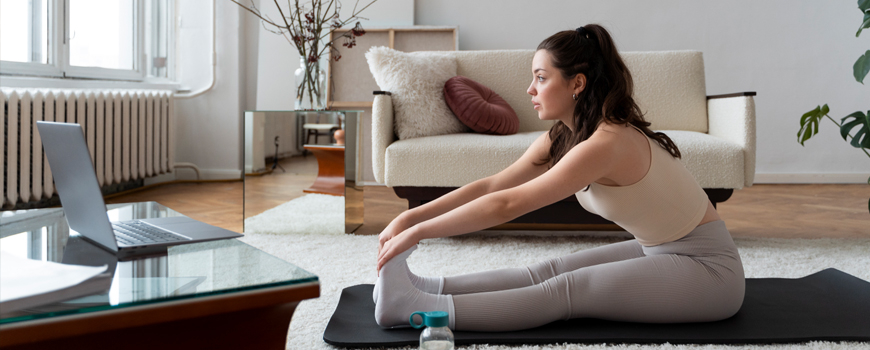If you’re between 18 and 35, don’t have the time (or desire) to hit the gym, and want a plan that actually works, this article is for you. You’ll learn what sitting too much does to your body, how to train effectively at home or outdoors, how to eat well without extreme diets, and which products can support you along the way.
Why This Matters
Overweight in the EU:
More than half of adults in the EU are overweight (including obesity). Among the youngest group (16-24), the rate is lower (~20%), but it rises steadily with age. Bulgaria has one of the lowest rates of obesity among women (9.8%), but the overall risks of a sedentary lifestyle remain high.
Physical inactivity:
According to the 2022 Eurobarometer, 45% of Europeans never exercise.
Worldwide:
In 2022, about 1 in 3 adults globally failed to meet movement guidelines; if trends continue, by 2030 the share will exceed 35%.
Bulgarian perspective:
In 2019, only 11.3% of Bulgarian adults reported reaching at least 150 minutes of moderate weekly activity—the lowest in the EU. This shows huge potential for improvement through small, smart steps.
Why young people skip activity:
Excessive screen time, study or work in front of a computer, irregular schedules, stress and lack of sleep, convenient transport, and low motivation for “boring” workouts.
What Sedentary Living Does
More hours spent sitting are linked to higher risks of early death, cardiovascular disease, and type 2 diabetes—especially when there’s not enough physical activity to offset it.
The good news: 30-40 minutes of moderate to vigorous activity a day can “cancel out” much of the risk from long sitting sessions.
Even steps matter: more steps = lower risk. Benefits continue well beyond 8-10k steps per day.
The Science in Brief
WHO Guidelines: 150-300 min/week of moderate activity, or 75-150 min/week of vigorous activity, plus muscle-strengthening exercises ≥2 times/week. Activity no longer needs to be in 10-minute bouts—every movement counts.
Getting Fit at Home: Equipment, Plan, and Exercises
Minimal equipment: a mat, resistance bands, two dumbbells—or improvise with water bottles, a backpack with books, or a sturdy chair.
How to train (20-30 min, 3-4x per week):
1. Warm-up (3-5 min): mobility for shoulders/hips, light squats, arm swings.
2. Main circuit (15-20 min): 3-4 rounds, 45 sec work / 15 sec rest:
- Squats / weighted squats (backpack)
- Push-ups (knees/chair for easier, pause for harder)
- Hip thrust / glute bridge
- Rows with band/backpack
- Plank (30-45 sec)
3. Finisher (3 min): e.g. mini ladder of jumps + push-ups: 3-2-1 reps × 3 sets.
4. Stretch (2-3 min): calves, thighs, chest/back.
Progression:
Add 1 more round per week or +5-10 sec per exercise.
When 45 sec feels “easy,” switch to harder variations (pistol squat to bench instead of basic squat, elevated push-ups, etc.).
Monitor intensity: if you breathe faster but can still say a few words, you’re in the right zone. If you can’t finish a sentence, the intensity is too high—dial it back.
Getting Fit in the Park
Outdoor workout ideas (25-35 min):
1. Strength circuit on bars (3-4 rounds):
- Pull-ups (or Australian pull-ups) - 5-8 reps
- Dips - 6-10 reps
- Bulgarian split squats (bench support) - 8-12 reps per leg
- Plank with shoulder taps - 20 total
Bench + track session:
- 5 × (30 sec fast run - 90 sec walk)
- Between intervals: 10 hip raises on bench + 10 push-ups on bench
Long strides:
- 0-60 min brisk walk/light jog; aim for 8-12k steps daily as a baseline for more movement.
Tips: cap + water in summer, light/reflective clothing for evenings, minimal gear (band + hand chalk for pull-ups).
Eating: Simple, Practical, Sustainable
- Protein in every meal - supports satiety and muscle maintenance. Research shows ~1.6 g protein/kg/day is enough for most people aiming to build or preserve muscle.
- Fiber daily - aim for ≥25 g/day (vegetables, fruits, legumes, whole grains, seeds).
- Plate rule: half with vegetables/salad; one-quarter protein (eggs, fish, meat, tofu, cottage cheese); one-quarter carbs (whole grains, potatoes, legumes); add 1-2 tbsp healthy fats (olive oil, nuts, seeds, avocado).
- Drinks: water as your base; coffee/tea fine pre-workout; alcohol minimal (slows recovery).
- Calorie deficit: for fat loss, reduce calories moderately, keep protein high, and strength-train 2-3x/week.
4-Week Starter Program (Home or Park)
Week 1: 3 × 20-25 min (home circuit).
Week 2: 3-4 × 25-30 min; add 1 interval session outdoors.
Week 3: 4 sessions; increase to 4 rounds; add pull-ups/Australian rows.
Week 4: 4+ sessions; aim for 8-12k steps/day; add a finisher or more resistance (heavier backpack/band).
Weekly Mini-Goals:
Step it up: add +1,500-2,000 steps per day each week until you reach 8-10k daily.
Eat more veggies: add ~150-200 g extra daily until you reach 3-4 servings/day.
Sleep better: at least one evening per week without screens before bed for higher-quality rest.
Support from Zdravnitza
In Zdravnitza you’ll find practical helpers for an active lifestyle: marine magnesium (alone or combined with calcium + vitamin D3) to support normal muscle function and reduce tiredness; different forms of collagen (powder or capsules) for joint and connective tissue health; and coconut water, a natural source of potassium and electrolytes for hydration after exercise. These products don’t replace balanced nutrition and movement but can be a convenient support for recovery, hydration, and meeting your daily nutrient needs while training or upping your step count.



